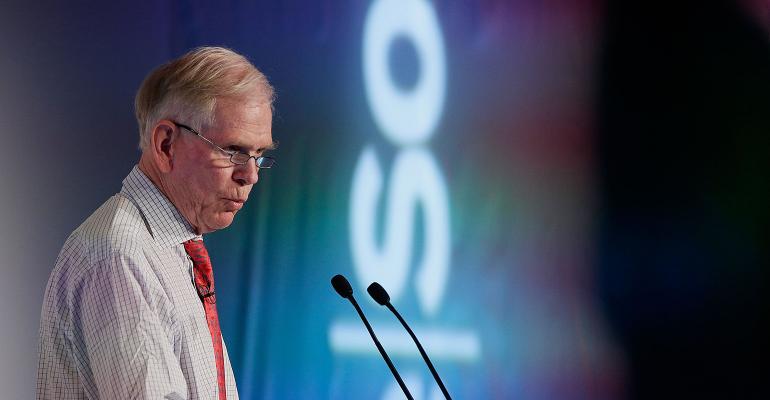The past few years haven’t been kind to value investors like Jeremy Grantham, founder of money manager GMO (Grantham Mayo Van Otterloo), who rose to fame after calling the stock market crash of 2000.
He says the mean reversion principles that accurately guided investors from 1935 until about 2000 have been circumvented since then. What has changed is that since 1998, price-earnings ratios and profit margins have outstripped their historical averages, giving the advantage to growth investors. That change stems largely from the massive monetary easing implemented under Federal Reserve Chairs Alan Greenspan, Ben Bernanke and Janet Yellen from the late 1990s until now, Grantham says.
This doesn’t mean the cupboard is bare for GMO’s portfolio managers. Going forward, Grantham, 78, sees investment opportunities in agriculture and clean energy, thanks to climate change and resource constraints. He finds emerging markets appealing too.
Grantham recently chatted with Wealth Management.com about these topics and his views on financial advisors.
WealthManagement.com: What are the most interesting changes you’ve seen in the investment business since you began in 1968?
Jeremy Grantham: The market was extremely well-behaved from 1935 until 2000. It was an orderly world in which to be a value manager: there was mean reversion. If a value manager was patient, he was in heaven. The market outperformed when it was it cheap, and when it got expensive, it cracked.
Since 2000, it’s become much more complicated. The rules have shifted. We used to say that this time is never different. I think what has happened from 2000 until today is a challenge to that. Since 1998, price-earnings ratios have averaged 60 percent higher than the prior 50 years, and profit margins have averaged 20 to 30 percent higher. That’s a powerful double whammy.
Diehard Ben Grahamites underestimated what earnings and stock prices would do. That began to be a drag after 1998.
In 2000, there was a classic bubble driven by the technology sector and eventually it blew up, leaving us well-positioned. In the Greenspan-Bernanke-Yellen era, the market rallied on housing, and then there was the first truly global bubble in 2007, creating another opportunity to ply our trade. But underneath the surface things started to change.
WM: How so?
JG: The price-earnings and profit margin increases. Corporations got more monopoly power and more power in government. The current market era doesn’t feel like a bubble — it’s not euphoric yet like the housing bubble of 2005. It’s more that we have been climbing the wall of worry.
So why have prices risen so high without a hint of euphoria — at least until very recently — or a perfect economy? My answer is that the discount rate structure has dropped by two percentage points. The yield on stocks is down by that amount and bonds too. The market has adjusted, reflecting low rates, low inflation and high profit margins.
With value investing and mean reversion, you have to be careful with saying this time is never different. Things do change. I was really lucky in that the first 30 years of my career were similar to the prior 30 years. But 1997 was very bad preparation for the next 20 years.
[Value] investors have overweighted the past. The Fed [easing] represents a regime change. That’s perhaps the most powerful change in my career.
WM: What changes do you see coming in the future for the investing business?
JG: The big change in the fundamental investing world will come from what we usually consider externalities: climate change and resource limits. We have grown so far and fast, and our population is so big, that we have chewed up safety margins.
A couple years of growing problems with agriculture would mean trouble in Africa and elsewhere. It would mean immigration destabilizing Europe and the rest of the world. The good news is that most of the world realizes the need to adjust to a changing climate.
WM: What kind of investment are we talking about?
JG: The money needed is in the tens to scores of trillions of dollars. Electric cars will displace internal combustion engines and fast. In 20 years it will be a done deal. Battery costs have dropped 70 percent in the last nine years. Solar panels have dropped a similar amount. Wind power is cheaper now too.
In 10 years it will be even better, fossil fuels will be more expensive and there will be a carbon tax. To make it all work, you need a larger grid to balance all these sources. In 50 years, I think the problems will be solved and there will be enough cheap energy to get the job done.
The bigger problem is dealing with agriculture and population growth in a world with more difficult growing conditions. We have to completely change agriculture with new technology, which we haven’t started.
WM: Do you see other attractive investment opportunities?
JG: There’s a greater [economic] growth rate in emerging markets. Compared to the rest of the world, emerging market equities are substantially discounted. Maybe they are overpriced by the standards of the good old days, but then the U.S. is extremely overpriced and other developed markets are moderately overpriced.
WM: What do you see as the strengths and weaknesses of financial advisors when it comes to investing?
JG: Career risk makes it hard for anyone to level with clients and tell them the truth when it’s inconvenient and embarrassing. Sometimes what’s best for us [advisors] isn’t for the client.
Advisors have done an OK job, but not stellar. They have sold too many things with high fees instead of index products. The only reason not to index is if you have a special skill in portfolio management. There is nothing more useless than a mediocre investment advisor.
The best thing advisors do is keeping investors in the stock market more than they otherwise would be.





